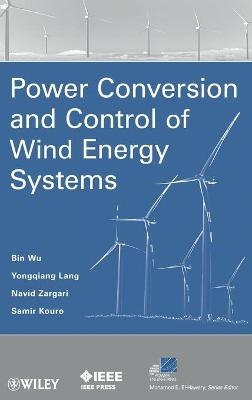
Power Conversion and Control of Wind Energy Systems
Wiley-IEEE Press (Verlag)
978-0-470-59365-3 (ISBN)
The book presents the latest power conversion and control technology in modern wind energy systems. It has nine chapters, covering technology overview and market survey, electric generators and modeling, power converters and modulation techniques, wind turbine characteristics and configurations, and control schemes for fixed- and variable-speed wind energy systems. The book also provides in-depth steady-state and dynamic analysis of squirrel cage induction generator, doubly fed induction generator, and synchronous generator based wind energy systems. To illustrate the key concepts and help the reader tackle real-world issues, the book contains more than 30 case studies and 100 solved problems in addition to simulations and experiments. The book serves as a comprehensive reference for academic researchers and practicing engineers. It can also be used as a textbook for graduate students and final year undergraduate students.
BIN WU, PhD, is a Professor in the Department of Electrical and Computer Engineering at Ryerson University (Canada). He is an NSERC/Rockwell Automation Industrial Research Chair and the founder of the Laboratory for Electric Drive Applications and Research (LEDAR). He is a Fellow of the Institute of Electrical and Electronics Engineers, Engineering Institute of Canada, and Canadian Academy of Engineering. YONGQIANG LANG, PhD, is a Senior Engineer in the State Grid Electric Power Research Institute (China). He worked in the LEDAR WindTech Laboratory at Ryerson University from November 2006 to June 2009 as a postdoctoral fellow in the area of wind power. NAVID ZARGARI, PhD, is a leading expert in medium voltage drives and a practicing engineer for fifteen years. He has been with the Medium Voltage Business of Rockwell Automation Canada since 1994, and has in-depth knowledge of many aspects of adjustable speed drives and wind energy systems. SAMIR KOURO, PhD, is a research academic in the Electronics Engineering Department of Universidad Tecnica Federico Santa Maria (Chile).
Preface. List of Symbols.
Acronyms and Abbreviations.
1. Introduction.
1.1 Introduction.
1.2 Overview of Wind Energy Conversion Systems.
1.3 Wind Turbine Technology.
1.4 Wind Energy Conversion System Configurations.
1.5 Grid Code.
1.6 Summary.
2. Fundamentals of Wind Energy Conversion System Control.
2.1 Introduction.
2.2 Wind Turbine Components.
2.3 Wind Turbine Aerodynamics.
2.4 Maximum Power Point Tracking (MPPT) Control.
2.5 Summary.
3. Wind Generators and Modeling.
3.1 Introduction.
3.2 Reference Frame Transformation.
3.3 Induction Generator Models.
3.4 Synchronous Generators.
3.5 Summary.
4. Power Converters in Wind Energy Conversion Systems.
4.1 Introduction.
4.2 AC Voltage Controllers (Soft Starters).
4.3 Interleaved Boost Converters.
4.4 Two-Level Voltage Source Converters.
4.5 Three-Level Neutral Point Clamped Converters.
4.6 PWM Current Source Converters.
4.7 Control of Grid-Connected Inverter.
4.8 Summary.
5. Wind Energy System Configurations.
5.1 Introduction.
5.2 Fixed Speed WECS.
5.3 Variable Speed Induction Generator WECS.
5.4 Variable-speed Synchronous Generator WECS.
5.5 Summary.
6. Fixed-Speed Induction Generator WECS.
6.1 Introduction.
6.2 Configuration of Fixed-Speed Wind Energy Systems.
6.3 Operation Principle.
6.4 Grid Connection with Soft Starter.
6.5 Reactive Power Compensation.
6.6 Summary.
7. Variable-Speed Wind Energy Systems with Squirrel Cage Induction Generators.
7.1 Introduction.
7.2 Direct Field Oriented Control.
7.3 Indirect Field Oriented Control.
7.4 Direct Torque Control.
7.5 Control of Current Source Converter Interfaced WECS.
7.6 Summary.
8. Doubly-Fed Induction Generator Based WECS.
8.1 Introduction.
8.2 Super- and Sub-synchronous Operation of DFIG.
8.3 Unity Power Factor Operation of DFIG.
8.4 Leading and Lagging Power Factor Operation.
8.5 A Steady-State Performance of DFIG WECS.
8.6 DFIG WECS Start-up and Experiments.
8.7 Summary.
9. Variable-Speed Wind Energy Systems with Synchronous Generators.
9.1 Introduction.
9.2 System Configuration.
9.3 Control of Synchronous Generators.
9.4 SG Wind Energy System with Back-to-back VSC.
9.5 DC/DC Boost Converter Interfaced SG Wind Energy Systems.
9.6 Reactive Power Control of SG WECS.
9.7 Current Source Converter Based SG Wind Energy Systems.
9.8 Summary.
Appendix A. Per Unit System.
Appendix B. Generator Parameters.
Appendix C. Problems and Answers Manual.
| Reihe/Serie | IEEE Series on Power Engineering |
|---|---|
| Zusatzinfo | Photos: 20 B&W, 0 Color; Drawings: 150 B&W, 0 Color |
| Sprache | englisch |
| Maße | 165 x 236 mm |
| Gewicht | 794 g |
| Themenwelt | Technik ► Elektrotechnik / Energietechnik |
| Technik ► Umwelttechnik / Biotechnologie | |
| ISBN-10 | 0-470-59365-2 / 0470593652 |
| ISBN-13 | 978-0-470-59365-3 / 9780470593653 |
| Zustand | Neuware |
| Haben Sie eine Frage zum Produkt? |
aus dem Bereich


